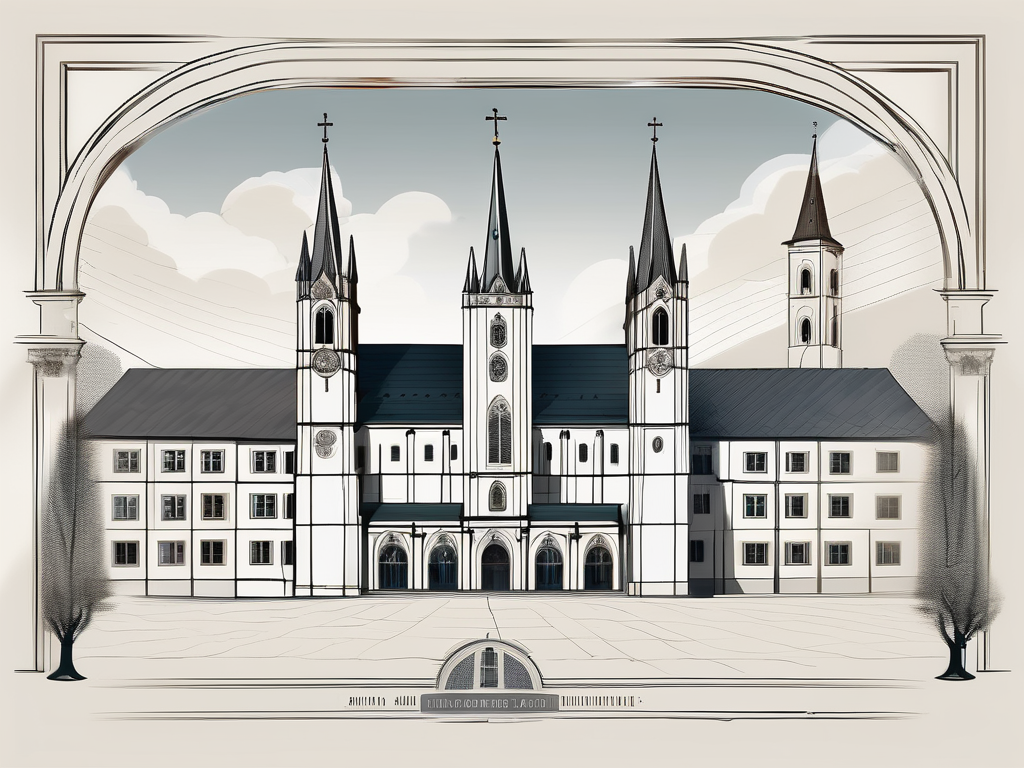When it comes to historical churches, there is a treasure trove of stories, significance, and beauty waiting to be explored. These magnificent structures have witnessed the passage of time and have played a crucial role in shaping our history and culture. Join us on a journey as we delve into the importance of historical churches, the evolution of their architecture, noteworthy examples from around the world, the challenges of preserving them, and their place in the future.
Understanding the Importance of Historical Churches
Historical churches hold a special place in our collective memory, symbolizing faith, community, and devotion. They have served as places of worship, centers of social and cultural activities, and even asylum during times of conflict. But their significance transcends religious boundaries, as they embody the spirit of human creativity, architectural excellence, and historical narratives.
When we step into a historical church, we are transported to a different time and place. The hallowed halls echo with the prayers of generations past, carrying with them the hopes, dreams, and struggles of those who sought solace within these sacred walls. These churches have stood the test of time, weathering storms, wars, and societal changes, remaining steadfast in their purpose.
The Role of Churches in History
Throughout history, churches have been focal points for communities, acting not only as places of worship but also as spaces for education, governance, and community gatherings. They have witnessed important events, such as coronations, weddings, and funerals, and have often served as silent witnesses to societal changes and political upheavals. Their walls reverberate with stories of triumph and tragedy, making them invaluable historical artifacts.
Imagine standing in a medieval cathedral, its towering arches reaching towards the heavens. You can almost hear the chants of monks, the harmonious melodies of choirs, and the whispers of pilgrims seeking spiritual enlightenment. These churches were not just places of religious significance, but also centers of intellectual and artistic pursuits. Monastic libraries preserved ancient texts, while intricate sculptures and paintings adorned the walls, depicting biblical stories and saints.
Architectural Significance of Historical Churches
Aside from their historical importance, these churches also showcase architectural marvels that reflect different time periods and artistic styles. From soaring spires to intricate stained glass windows, each detail tells a story. The grandiosity of Gothic cathedrals, the simplicity of Byzantine structures, and the elegance of Baroque designs all contribute to the rich tapestry of architectural heritage that historical churches offer.
Take a moment to appreciate the craftsmanship that went into creating these architectural wonders. The meticulous carving of stone, the delicate brushstrokes on frescoes, and the skillful arrangement of colorful glass pieces in a stained glass window. These churches were not only places of worship but also living works of art, where master craftsmen poured their hearts and souls into every detail.
As you walk through the nave of a historical church, let your eyes wander and marvel at the play of light and shadow, the intricate tracery of stone, and the delicate interplay of colors in the stained glass. Each architectural element tells a story, revealing the cultural and artistic influences of the time. From the Romanesque arches to the Renaissance domes, these churches are a testament to the ingenuity and creativity of human beings throughout history.
The Evolution of Church Architecture Over the Centuries
The development of church architecture is a fascinating journey that reflects the changing tastes and beliefs of different eras. From the early Christian and Byzantine styles to the Romanesque and Gothic periods, and finally the Renaissance and Baroque influences, each era brought its unique flair to the design and construction of churches.
Early Christian and Byzantine Architecture
In the early years of Christianity, churches were simple in design, reflecting the humble origins of the faith. However, as the religion gained prominence, elaborate places of worship emerged, incorporating Byzantine elements such as domes, mosaics, and intricate iconography.
One notable example of early Christian architecture is the Basilica of San Vitale in Ravenna, Italy. Built in the 6th century, this church showcases the Byzantine influence with its stunning mosaics depicting biblical scenes and figures. The domed ceiling, supported by elegant columns, adds a sense of grandeur to the space.
As Christianity spread throughout the Byzantine Empire, churches became not only places of worship but also symbols of imperial power. The Hagia Sophia in Istanbul, Turkey, is a prime example of Byzantine architecture. Its massive dome, supported by pendentives, is a marvel of engineering and a testament to the Byzantine Empire’s architectural prowess.
Romanesque and Gothic Styles
The Romanesque period introduced the use of rounded arches, thick walls, and small windows, creating a sense of strength and solidity in church structures. This architectural style can be seen in the Abbey Church of Saint-Savin-sur-Gartempe in France. The church’s sturdy stone walls and small, narrow windows evoke a sense of protection and fortification.
However, the Romanesque style eventually gave way to the Gothic style, which revolutionized church architecture. Gothic cathedrals, such as Notre-Dame de Paris in France, reached new heights both literally and metaphorically. The use of pointed arches, ribbed vaults, and flying buttresses allowed for taller and more spacious interiors, creating an ethereal atmosphere that aimed to elevate the soul.
Stained glass windows became a hallmark of Gothic architecture, as they allowed natural light to filter into the sacred space, illuminating the stories depicted in vibrant colors. The Chartres Cathedral in France is renowned for its stunning stained glass windows, which depict biblical narratives and saints in intricate detail.
Renaissance and Baroque Influences
During the Renaissance, churches embraced classical influences, with symmetrical designs, harmonious proportions, and a focus on beauty and balance. The Basilica di Santa Maria del Fiore in Florence, Italy, exemplifies this style with its dome designed by Filippo Brunelleschi. The dome’s elegant structure and harmonious integration with the rest of the church showcase the Renaissance ideals of mathematical precision and aesthetic harmony.
As the Renaissance gave way to the Baroque period, churches became more opulent and theatrical in their design. The Church of the Gesù in Rome, Italy, is a prime example of Baroque architecture. Its façade, adorned with intricate sculptures and dramatic elements, draws the eye and evokes a sense of awe and wonder. Inside, the church’s ornate altarpieces, gilded decorations, and elaborate frescoes create a rich visual feast for worshippers.
Church architecture has continuously evolved throughout the centuries, reflecting the cultural, religious, and artistic trends of each era. From the simplicity of early Christian churches to the grandeur of Gothic cathedrals and the opulence of Baroque masterpieces, these architectural marvels continue to inspire and captivate visitors with their beauty and historical significance.
Noteworthy Historical Churches Around the World
From the iconic cathedrals of Europe to the ancient churches of the Middle East and the colonial churches of the Americas, historical churches can be found in every corner of the globe, each with its own unique story to tell.
Let’s take a closer look at some of these remarkable churches and delve into the fascinating details of their history and significance.
Europe’s Iconic Cathedrals
Europe boasts some of the most renowned historical churches, with cathedrals like Notre-Dame in Paris, St. Peter’s Basilica in Vatican City, and the breathtaking Sagrada Familia in Barcelona standing as testaments to human ingenuity and devotion.
Notre-Dame, a masterpiece of Gothic architecture, has witnessed centuries of history unfold within its walls. From royal coronations to the French Revolution, this cathedral has stood as a symbol of resilience and faith. Its intricate stained glass windows and towering spires continue to awe visitors from around the world.
St. Peter’s Basilica, located in the heart of Vatican City, is the largest church in the world and a pilgrimage site for millions of Catholics. Its grandeur and opulence reflect the power and influence of the Catholic Church throughout history. The basilica houses priceless works of art, including Michelangelo’s famous sculpture, the Pietà.
The Sagrada Familia, designed by the visionary architect Antoni Gaudí, is a true marvel of modern architecture. This unfinished masterpiece has been under construction for over a century and continues to captivate visitors with its intricate facades and unique blend of Gothic and Art Nouveau elements.
Ancient Churches of the Middle East
The Middle East is home to ancient churches that bear witness to centuries of religious diversity, including the magnificent Hagia Sophia in Istanbul, the Church of the Nativity in Bethlehem, and the captivating Saint Catherine’s Monastery in Egypt.
Hagia Sophia, originally built as a Byzantine cathedral, later transformed into an Ottoman mosque, and now serving as a museum, is a testament to the rich and complex history of Istanbul. Its massive dome and stunning mosaics showcase the architectural brilliance of the Byzantine Empire.
The Church of the Nativity, located in Bethlehem, is one of the oldest continuously operating churches in the world. It is believed to be built on the site where Jesus Christ was born, making it a significant pilgrimage destination for Christians worldwide. The church’s ancient walls and ornate decorations transport visitors back in time.
Saint Catherine’s Monastery, situated at the foot of Mount Sinai, is a UNESCO World Heritage site and one of the oldest Christian monasteries in the world. Its remote location and well-preserved Byzantine architecture make it a truly awe-inspiring place to visit. The monastery’s library houses a vast collection of ancient manuscripts, including the famous Codex Sinaiticus.
Colonial Churches of the Americas
In the Americas, colonial churches serve as reminders of the early spread of Christianity. From the awe-inspiring Cusco Cathedral in Peru to the charming San Xavier del Bac Mission in Arizona, these churches offer glimpses into the history and resilience of local communities.
The Cusco Cathedral, located in the historic city of Cusco, was built on the foundations of an Inca palace after the Spanish conquest. Its ornate facade and lavish interior reflect the fusion of Spanish and indigenous cultures. The cathedral houses numerous religious artifacts and paintings from the colonial era.
San Xavier del Bac Mission, a beautiful example of Spanish colonial architecture, is known as the “White Dove of the Desert.” Located on the Tohono O’odham Nation reservation, this mission has been a spiritual and cultural center for the local community for over three centuries. Its intricately carved facade and vibrant interior decorations showcase the blending of European and Native American artistic traditions.
As we explore these remarkable historical churches, it becomes clear that they are not just places of worship, but also living testaments to the artistic, cultural, and religious heritage of humanity. Each church has its own unique story to tell, inviting us to marvel at the ingenuity and devotion of those who came before us.
Preservation and Restoration of Historical Churches
Ensuring the preservation and restoration of historical churches is a delicate and challenging task. These magnificent structures are often subjected to natural decay, human neglect, and the ravages of time, necessitating ongoing efforts to safeguard their heritage.
Challenges in Church Conservation
Preserving historical churches requires immense financial resources, skilled craftsmen, and a deep understanding of architectural heritage. The delicate balance between restoration and preserving authenticity can often be a point of contention, as different opinions on the best approach arise.
Modern Techniques in Restoring Ancient Churches
Thanks to advances in technology and restoration techniques, experts are better equipped to restore and conserve historical churches. From laser scanning and 3D modeling to innovative materials and meticulous craftsmanship, these approaches help ensure that the glory of these architectural gems can be enjoyed by future generations.
The Future of Historical Churches
As we look ahead, finding a balance between tourism and preservation becomes crucial in safeguarding the future of historical churches.
Balancing Tourism and Preservation
While tourism can provide much-needed resources for the upkeep of historical churches, it also poses challenges. Striking a balance between allowing visitors to experience these architectural wonders and protecting their fragile structures requires careful planning, crowd management, and sustainable tourism practices.
The Role of Churches in Modern Society
Beyond their historical and architectural significance, churches continue to play a vital role in modern society. They serve as spaces for reflection, community engagement, and cultural events, acting as both physical and spiritual anchors for the communities they belong to.
Exploring the rich heritage of historical churches is not only a journey through the annals of history but also an opportunity to appreciate the intricate craftsmanship, architectural brilliance, and enduring allure that these buildings offer. From the grand cathedrals of Europe to the hidden gems scattered across the world, historical churches tell stories that connect us to our past and inspire us to preserve them for generations to come.












